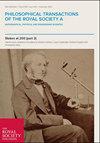The effects of solar variability on the Earth's climate
Philosophical Transactions of the Royal Society of London. Series A, Mathematical and Physical Sciences
Pub Date : 2003-01-15
DOI:10.1098/rsta.2002.1111
引用次数: 285
Abstract
The absolute value of total solar irradiance is not known to better than ca.0.3% but measurements from satellite instruments over the past two solar cycles have shown that it varies by ca.0.1% on this time-scale. Over longer periods its value has been reconstructed using proxy measures of solar activity, and these suggest that during the Maunder minimum in solar activity of the late 17th century it was 3−4 W m−2 lower than at present. Observational data suggest that the Sun has influenced temperatures on decadal, centennial and millennial time-scales, but radiative forcing considerations and the results of energy-balance models and general circulation models suggest that the warming during the latter part of the 20th century cannot be ascribed entirely to solar effects. However, chemical and dynamical processes in the middle atmosphere may act to amplify the solar impact. An analysis of zonal mean temperature data shows that solar effects may be differentiated from those associated with other factors such as volcanic eruptions and the El Niño Southern Oscillation.太阳变化对地球气候的影响
太阳总辐照度的绝对值不超过0.3%,但卫星仪器在过去两个太阳周期的测量表明,它在这个时间尺度上变化了0.1%。在更长的时期内,利用太阳活动的替代测量方法重建了它的值,这些值表明,在17世纪后期太阳活动的蒙德极小期,它比现在低3 - 4 W m−2。观测资料表明,太阳在年代际、百年和千年时间尺度上影响了温度,但辐射强迫因素以及能量平衡模式和环流模式的结果表明,20世纪后半叶的变暖不能完全归因于太阳效应。然而,中层大气中的化学和动力学过程可能会放大太阳的影响。对纬向平均温度数据的分析表明,太阳的影响可能与火山爆发和厄尔Niño南方涛动等其他因素有关。
本文章由计算机程序翻译,如有差异,请以英文原文为准。
求助全文
约1分钟内获得全文
求助全文
来源期刊
自引率
0.00%
发文量
0

 求助内容:
求助内容: 应助结果提醒方式:
应助结果提醒方式:


